See an icon of the Desert Southwest in Tucson. Here are the top things to do in Saguaro National Park, on both the east and west sides.
As an icon of the desert southwest, the Saguaro cactus evokes Saturdays watching Wile E. Coyote chase the Roadrunner. Or maybe it was a classic western filmed in the desert that conjures up thoughts of adventures on horseback. Regardless, when visitors think about Arizona, they probably envision a saguaro. Native to the Sonoran desert in southern Arizona and southeastern California, the Saguaro has a national park dedicated to it as a species. If you’re traveling through Tucson, it’s an easy road trip stop. Here are the top things to do in Saguaro National Park.
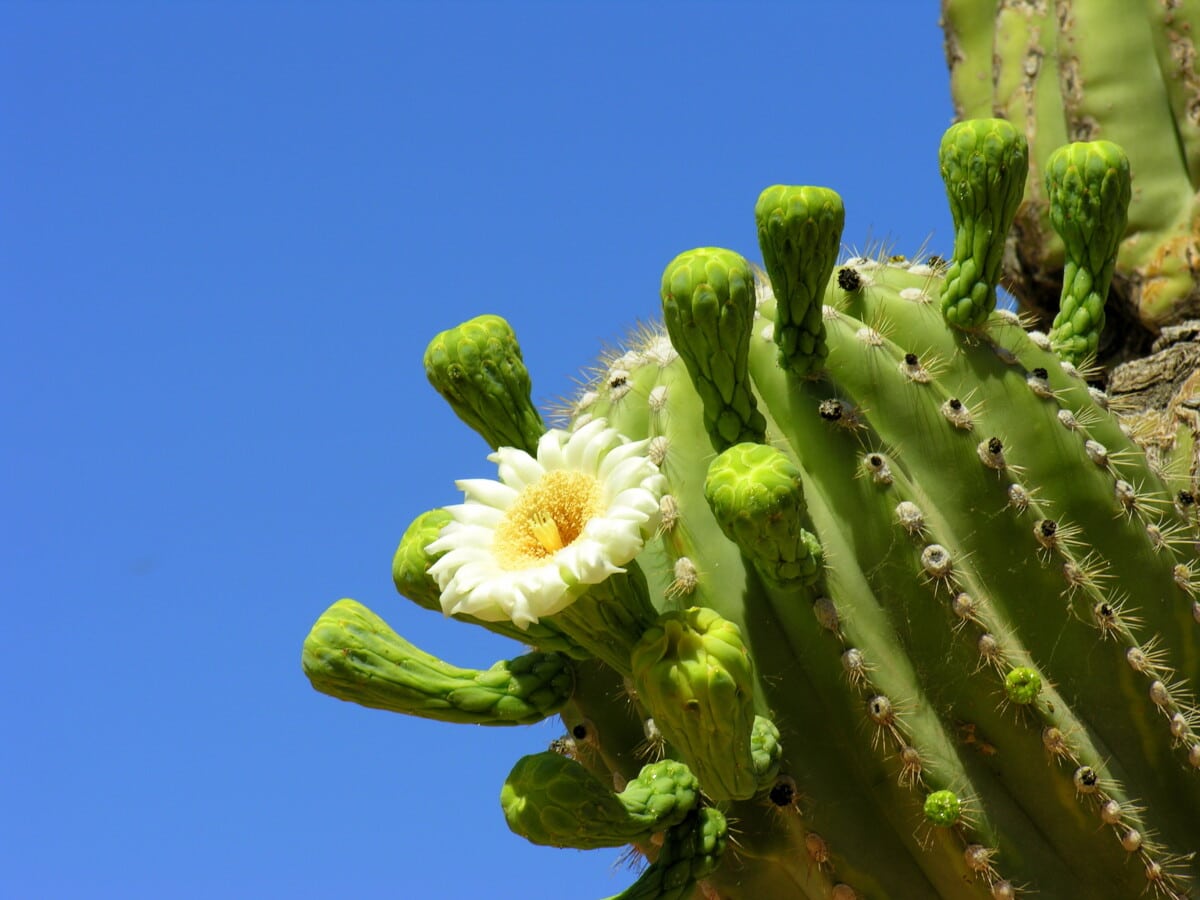
The Saguaro blossom is the Arizona state flower. Photo by Susan Lanier-Graham
If You Have Two Hours to Explore
As an avid road tripper, I use some national park sites as road trip stops during my journey. With its convenient location along Interstate 10 and proximity to Tucson, Saguaro National Park is an excellent road trip stop. The park offers a visitor center with interpretive displays and several short hikes for road trippers. Even for travelers without the time to get out and stretch their legs, the drive through each side of the park is enjoyable.
First, decide what you want to see. With two separate units of the park on different sides of Tucson, you can’t visit both sides in two hours. I made this mistake on my first visit.
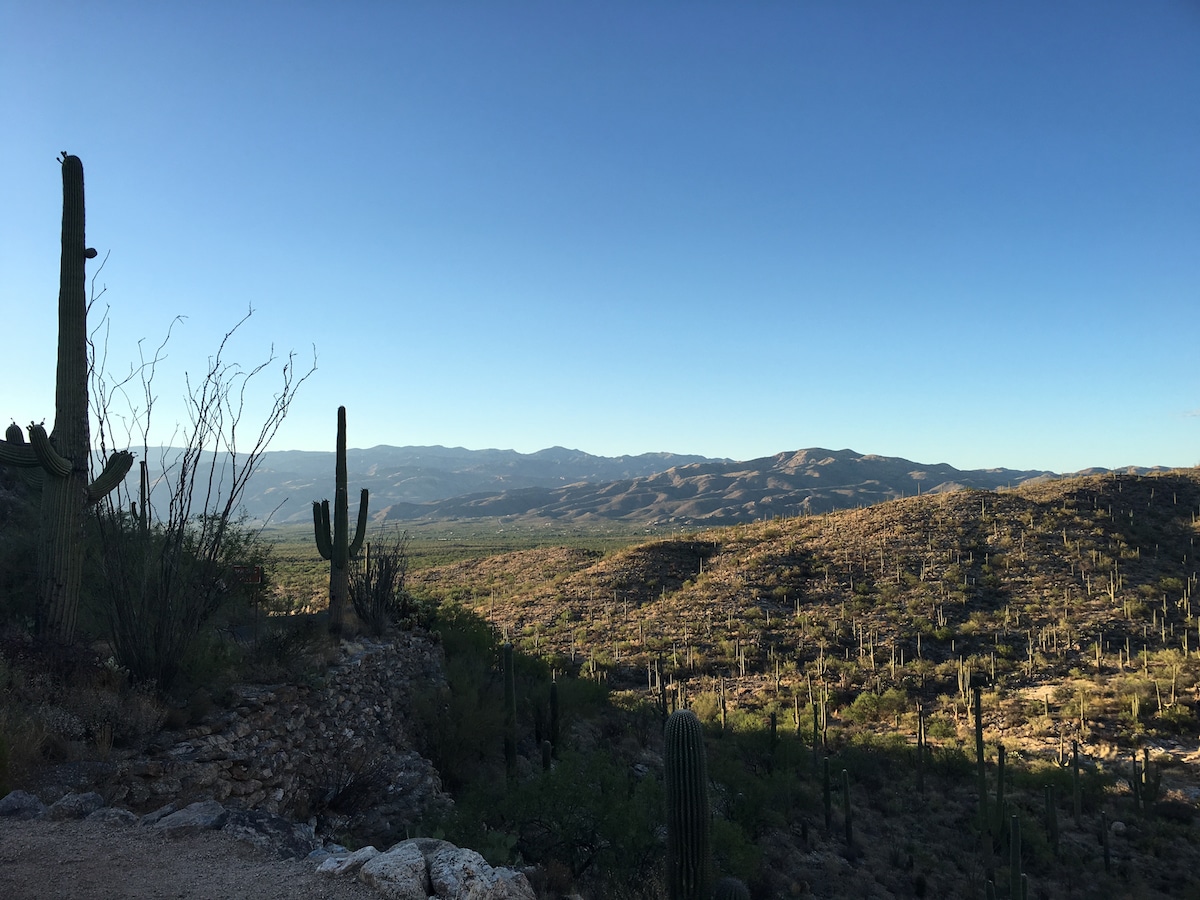
Cactus dot the hillside of the Rincon Mountains District. Photo by Catherine Parker
After visiting both sides of the park, I recommend the eastern side of the park, called the Rincon Mountain District, for first-time visitors. It offers the highest concentration of Saguaro cacti, easy to see from the park road. Drive along the Cactus Forest Loop Drive, then get out and walk the Desert Loop Ecology Trail. It’s a short, level walk with the famed saguaro cactus towering overhead. You might even see a roadrunner.
To enjoy desert mountain scenery and spot some petroglyphs, the west side of the park (Tucson Mountain District) is your destination. After stopping in the visitor center, take the Desert Discovery Trail. Then head to Signal Hill for the petroglyphs. Both trails are short, though the road to Signal Hill is unpaved, so consult with the rangers if you are concerned about the conditions.
Top Things to Do in Saguaro National Park
There are many things to do during your visit to Saguaro National Park. These are the top things I recommend after having visited several times.
- Southern Arizona offers unlimited opportunities for backcountry exploration. This third edition of Hiking Arizonas Cactus Country explores a broad swath of the Sonoran Desert that extends northward across the Mexican border and encompasses the southern third of Arizona.
Prices pulled from the Amazon Product Advertising API on:
Product prices and availability are accurate as of the date/time indicated and are subject to change. Any price and availability information displayed on [relevant Amazon Site(s), as applicable] at the time of purchase will apply to the purchase of this product.
Visitor Centers in Saguaro National Park
Each side of Saguaro National Park features a visitor center. Both offer maps and interpretive areas along with rangers to ask questions. You can stroll through the cactus garden at the visitor centers, which offers interpretive signs explaining the unique desert plants.
Red Hills Visitor Center is located on the west side of the park. On the east side, visit the Rincon Mountain Visitor Center. Find restrooms along with water outside of each. They are open daily from 9 am to 5 pm.
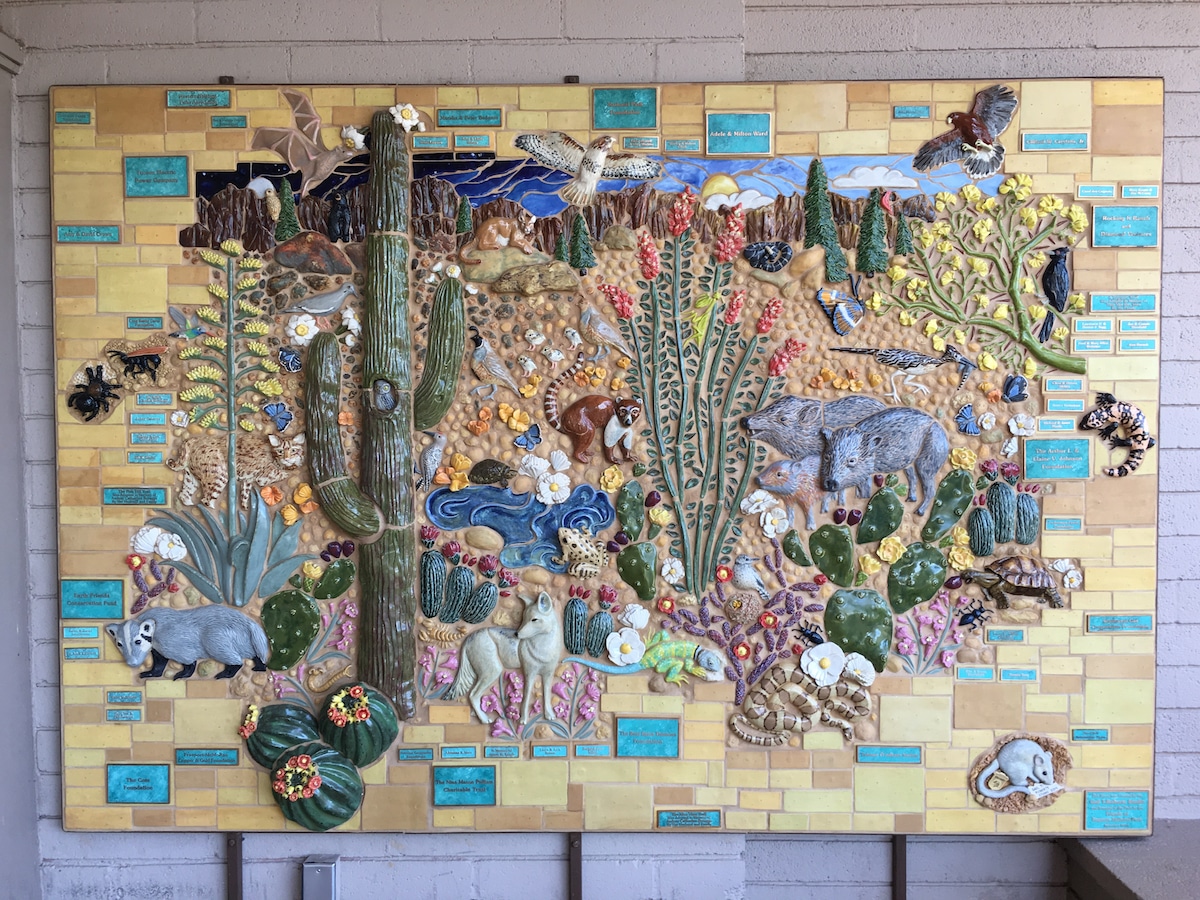
Learn about the desert at one of two visitor centers in the park. Photo by Catherine Parker
Hiking and Mountain Biking in Saguaro National Park
One of the best ways to see the park is on a hike. Both sides of the park offer hiking trails from easy to more advanced. Check in with a Park Ranger at the Visitor Center for questions about hiking trails and conditions. A map is also advised and available at the visitor center.
East Side of the Park
The Cactus Forest Loop Drive offers a few hikes on the east side.
- Desert Loop Ecology Trail—A quarter-mile accessible nature trail suitable for most. This is the only trail open to pets.
- Freeman Homestead Trail—A .9-mile trail with a 100-foot elevation to an old homestead.
- Mica View Trail—A 1.5-mile in-and-out trail off Cactus Forest Loop Drive can be joined with Cactus Forest Trail to make a 2-mile loop.
- Loma Verde Loop—A 3.8-mile loop (60-foot elevation gain) in the Cactus Forest area that joints the Pink Hill Trail and the Squeeze Pin to form a loop.
West Side of the Park
There are a couple of easily accessible trails on the west side of Saguaro National Park.
- Desert Discovery Trail—A .4-mile trail west of the Red Hills Visitor Center.
- Wild Dog Trail—A 1.8-mile in-and-out trail off of Hohokam Rd.
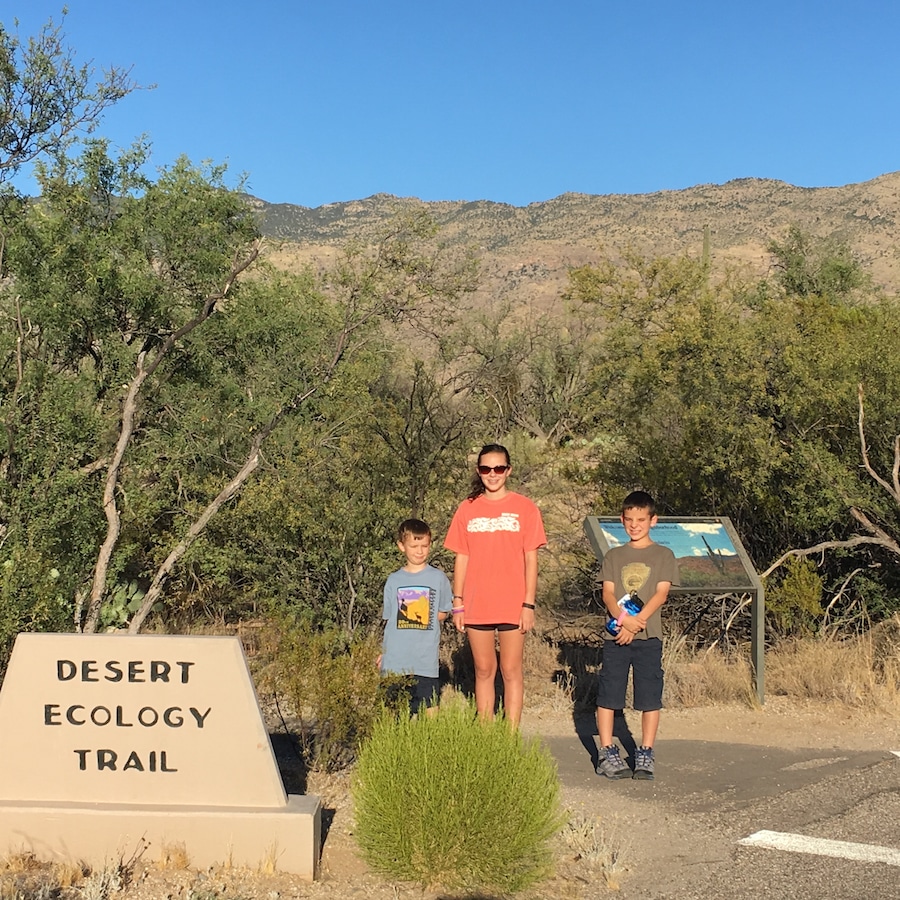
Take a hike along the Desert Ecology Trail. Photo by Catherine Parker
Petroglyphs at Saguaro National Park
Find the ancient stone drawings in the Tucson Mountain District (west side). With over 200 prehistoric petroglyphs, you can see them along the trail. The petroglyphs date back from 550 to 1500 years ago.
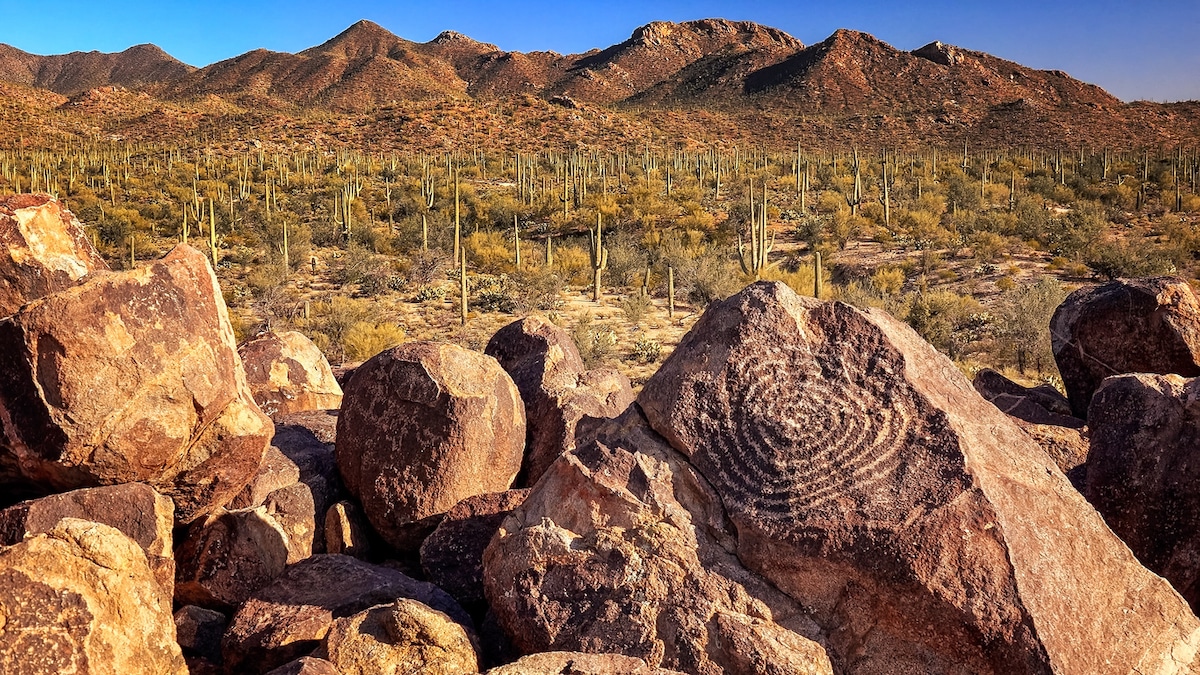
Hohokam petroglyphs are etched into rocks on the top of Signal Hill in Saguaro National Park. Photo by CrackerClips via iStock by Getty Images
Head to Signal Hill area, located off Golden Gate Rd. for a short walk (.1-mile with 40-foot elevation gain). This area features a picnic area and restrooms.
Note: Roads to Signal Hill are unpaved.
Where to Watch the Sunset at Saguaro National Park
Beach sunsets are inspiring, but some argue that desert sunsets are equally impressive (if not more so). Across the Southwest, sunsets are celebrated. Each side of the park offers prime sunset viewing locations.
On the East Side of the Park (Rincon Mountain), head to the Tanque Verde Ridge Trail, a half-mile hike off of Cactus Garden Dr. The Javalina Rocks Pull-Out is another top spot to watch the sunset without a hike.
On the west side, Gates Pass Scenic Lookout is popular, located in the Tucson Mountain Park, just south of the Saguaro National Park.
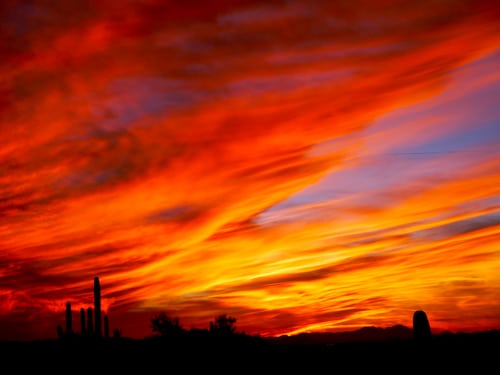
The sunset over the desert at Saguaro National Park. Photo courtesy Saguaro National Park
The Plants of Saguaro National Park
Adapted to the long periods of hot and dry weather, over 3,000 different species live between the two sides of the park. After a rain shower, the desert will transform from lifeless to lively with blooms and new green leaves.
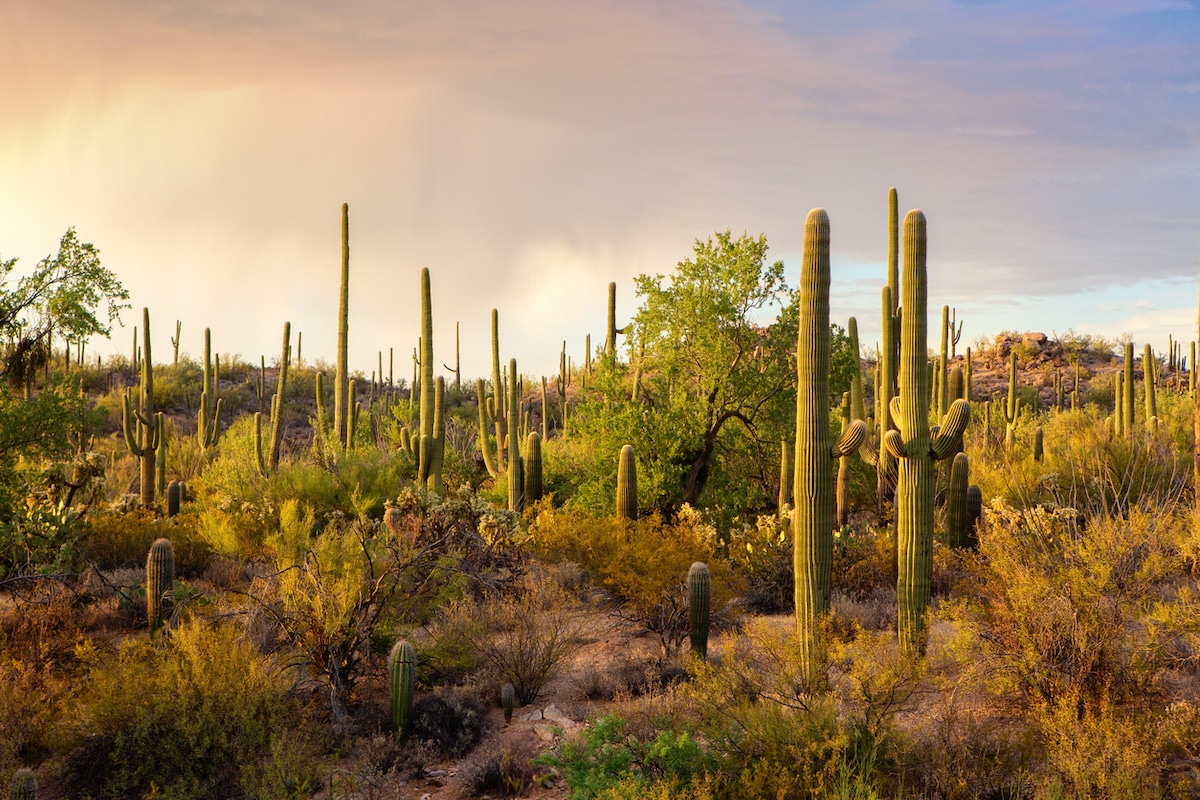
Cactus thickets in the rays of the setting sun before a thunderstorm, Saguaro National Park, Arizona. Photo by Antonel via iStock by Getty Images
Saguaro National Park is home to 25 different species of cacti. With blooms from yellow to hot pink, the cactus flowers are showy. Though looks can be deceiving in the Sonoran desert. For example, the soft-looking cholla cactus, also known as the Teddybear cactus, can be vicious. Its thorn might be small, but they are painful for those curious enough to touch (like kids and pets).
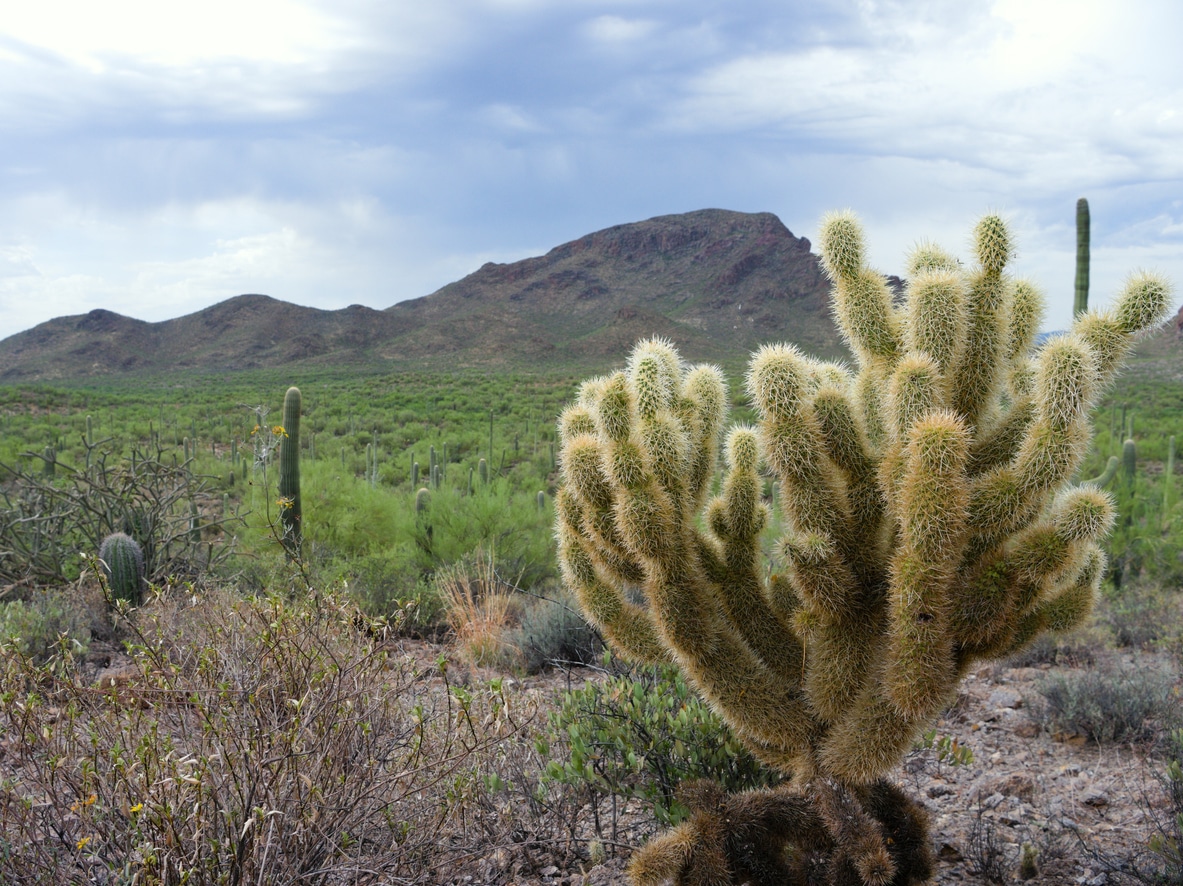
While it looks soft, the Cholla Cactus has a vicious bite. Avoid touching or getting too close to these cacti. Photo by Rachel Simpson via iStock by Getty Images
The Saguaro Cactus
The Saguaro is the star of the show. Native to the Sonoran Desert, the Saguaro is the largest cactus species in the park. To appreciate the towering cactus, you need to get up close.
First-time visitors are amazed at how tall a full-grown species is. Saguaro are incredibly slow-growing, putting on about an inch a year in their early years—so imagine how long some towering Saguaro have grown in the desert.

The iconic Saguaro cactus is a symbol of the desert southwest. Photo by Elizabeth R Rose
From April until June, mature Saguaros can bloom with creamy white blossoms that open overnight. The flower closes the following afternoon, a favorite of nectar-feeding bats and other insects. If pollinated, it will form fruit.
The Saguaro’s pleated skin helps it adsorb water quickly and store it for the long, dry days ahead. The Saguaro are host plants for other creatures, like the Gila woodpecker—one of several birds that nest in cavities they make in the Saguaro.

In this historic photo, “Old Granddaddy” was the largest saguaro in the park and was thought to be 300 years old. Photo courtesy Saguaro National Park
Wildflowers in Saguaro National Park
As a desert environment dedicated to cactus, there’s more to the desert landscape in Saguaro. From the Teddybear Cholla cactus (with deceptive-looking spines) to the Pinkflower hedgehog cactus, the desert can be a colorful place.
For wildflower blooms, visitors should visit from late February through March. The Saguaro bloom in late April, with their fruit ripening in June. Wildflowers are the best after winter rains, from California poppies to desert globemallow to Indian blanket.
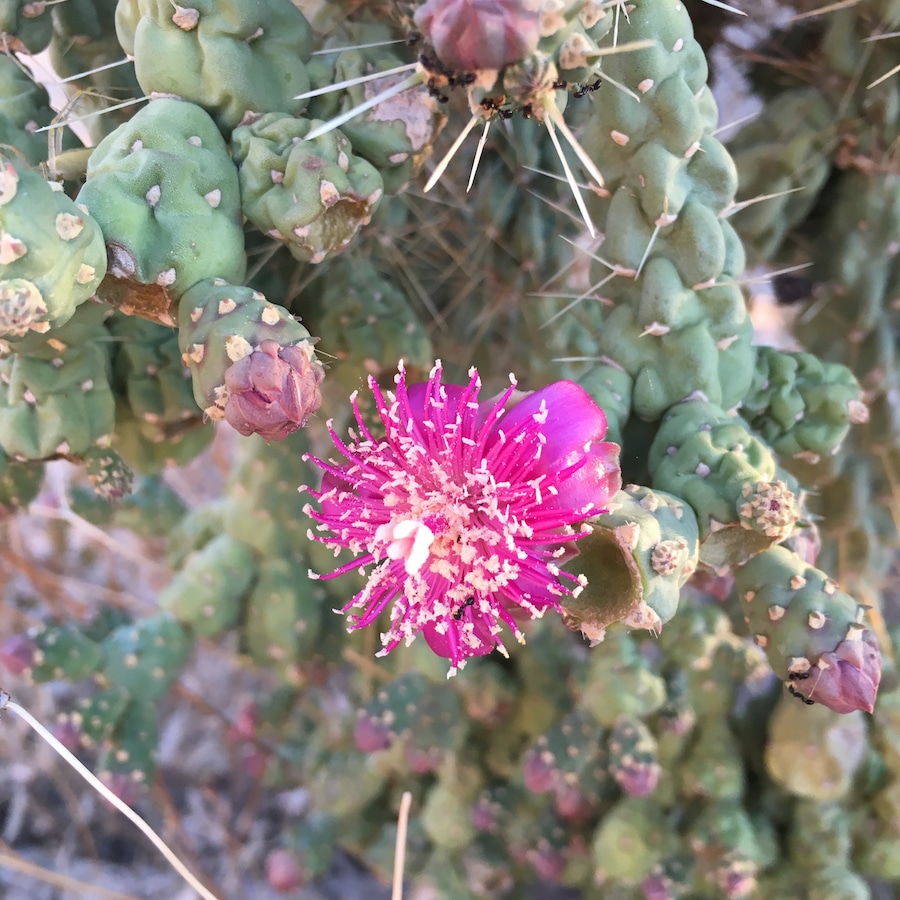
The pink cactus bloom is striking. Photo by Catherine Parker
Animals in Saguaro National Park
To the first-time visitor, the desert might seem devoid of animals. However, the animals start to pop out of their hiding places as visitors get closer. Gila monsters, Jackrabbits, and kangaroo rats are numerous at the lower elevations. In the higher regions of the park, black bears and whitetail deer are found.
With warm winter temperatures, Arizona is a birder paradise. In Saguaro, vermillion flycatchers and whiskered screech owls find a home in the desert, both hard-to-catch in the wild. More common desert birds are the Gila woodpeckers pecking homes into the Saguaro cactus to raise their young. The Mexican Jay and yellow-eyed juncos are frequently spotted at higher elevations.
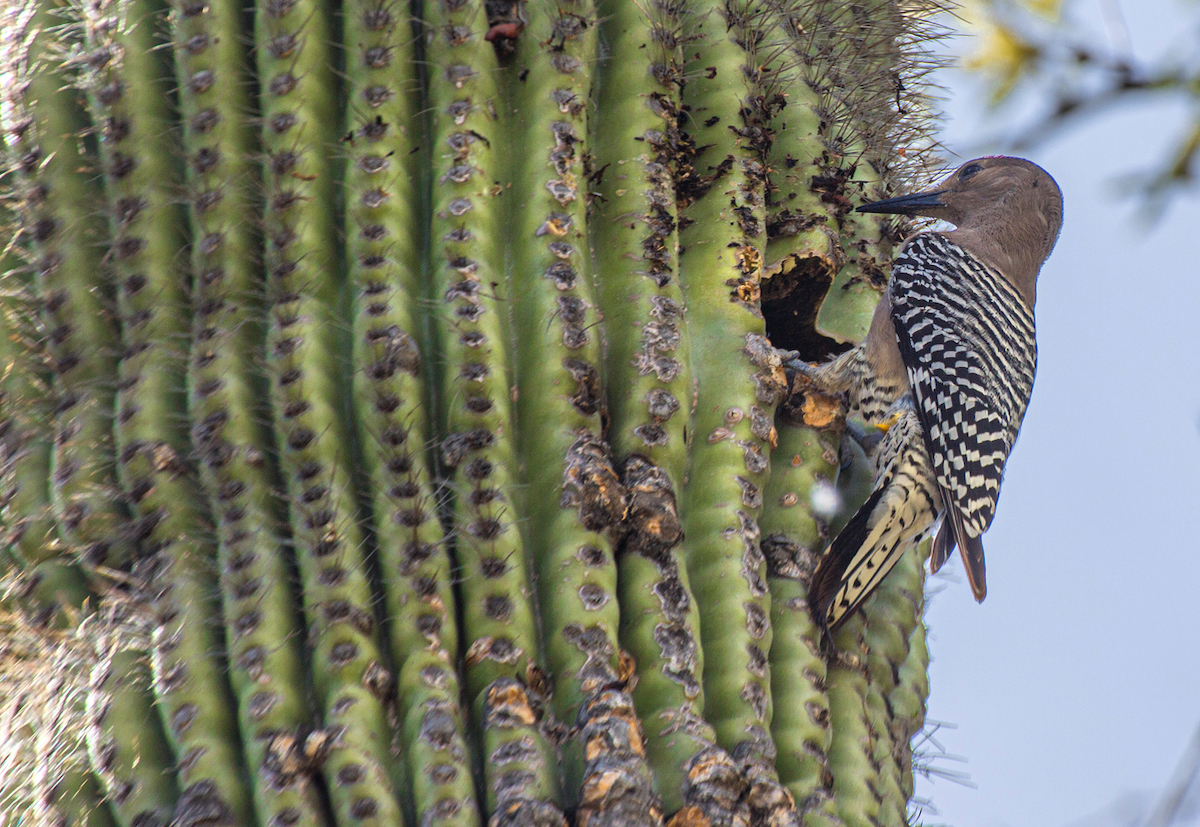
Gila Woodpeckers call the giant saguaro cacti their homes. Photo by kenileed via iStock by Getty Images
Family Fun in Saguaro National Park
The Junior Ranger Program is the go-to program for families to learn about a National Park Service site. It’s free and takes about two hours to complete. My kids love the Rangers’ badges after completing their booklet.
Pick up a booklet at the visitor center and complete it during your visit to be sworn in by a park ranger. No worries, you can mail the booklet back to Saguaro National Park if you don’t finish.
The History of Saguaro National Park
First protected as a national monument in 1933, President Herbert Hoover designated the land as Saguaro National Monument. Though several prominent residents of Arizona worked to preserve the native desert landscape in the 1920s.
Additional land has been added over the years, and the Tucson Mountain District (west side) was integrated into the national monument in 1961. In 1994, President Bill Clinton elevated the national monument to a national park.
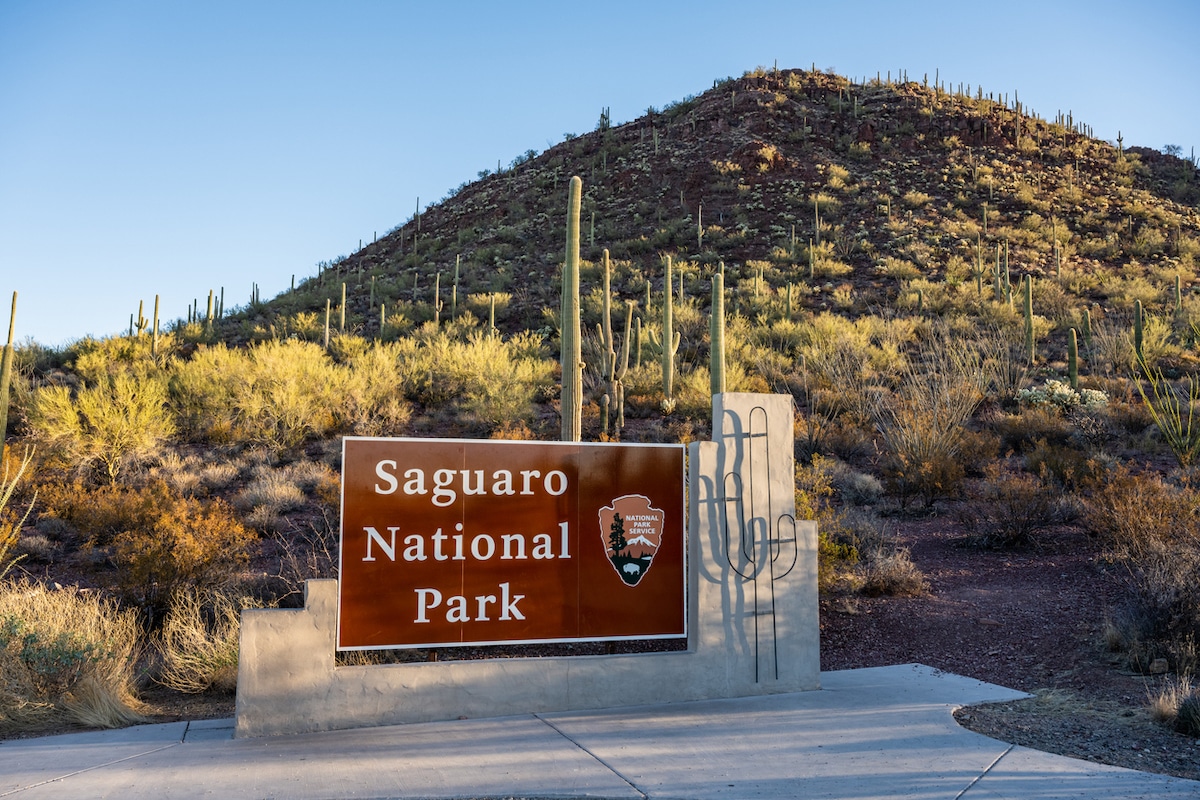
Saguaro National Monument became Saguaro National Park in 1994. Photo by kellyvandellen via iStock by Getty Images
The People of Saguaro
The desert landscape is protected though there are also cultural resources to see during your visit. The Hohokam people lived there from 500 to 1400 CE, leaving markers on several rocks in the Signal Hill Area.
Archeologists found evidence of Archaic people (3500 to 2100 BCE) who lived in what is now the park long before the Hohokam people arrived.
Old homesteads, along with their equipment, have been discovered in more modern history, like the Freeman Homestead. The Civilian Conservation Corps (CCC) also developed the area during the Great Depression by constructing several picnic shelters across the park.
Picnic Areas in Saguaro National Park
Find a picnic area at the Javalina Picnic Area and the Mica Picnic Area on the park’s east side. The Mam-A-Gah and the Signal Hill picnic areas are on the park’s west side.
Where to Stay in Saguaro National Park
Saguaro National Park doesn’t offer lodging on either side of the park. Both locations are close to Tucson, with numerous options for lodging and dining.
Camping in Saguaro National Park
The camping in Saguaro National Park is primitive and requires a multi-mile hike with an elevation change of at least 1,000 feet. You will need to fill out wilderness camping permits before you head out.
How to Get to Saguaro National Park
Both sides of Saguaro National Park are located around Tucson. It is about 15 miles from downtown Tucson to the Red Hills Visitor Center to reach the park’s west side. The Rincon Mountain Visitor Center is about 18 miles from the city center. Traveling from one side of the park to the other will take about an hour, depending on traffic. Each is about 30 miles apart. Tucson offers a mid-sized airport along with all traveler’s services.
Saguaro’s West Side is about 115 miles from Phoenix, Arizona. Phoenix is a better option for travelers arriving by air since it offers more flights from more air carriers. Both the Joshua Tree National Park in Southern California and Grand Canyon National Park in Arizona sit about 325 miles from the western portion of Saguaro.
Saguaro National Park is open 365 days a year and 24 hours a day. Use an America the Beautiful annual pass ($80) or purchase a 7-day pass for $25 per vehicle.
Articles Related to Visiting Saguaro National Park
- The Saguaro Cactus: A Must-See Arizona Icon
- 2 Days in Tucson, Arizona: The Ultimate Guide
- Free Yourself and Explore Tucson, AZ
- Tucson Gem Show: A World of Shopping and Sightseeing
- Ritz-Carlton, Dove Mountain
- Top Hotel Room: Tanque Verde Ranch, Tucson
- Explore Arizona’s Largest Sky Island at Chiricahua National Monument
- Exploring Gorgeous Gardiner, Montana
Visiting Saguaro National Park
Whether you have an hour or two or there to enjoy a weekend, Saguaro National Park offers an iconic desert landscape to explore and enjoy. From its namesake cactus to its hiking to its petroglyphs, spend your downtime enjoying the desert southwest.
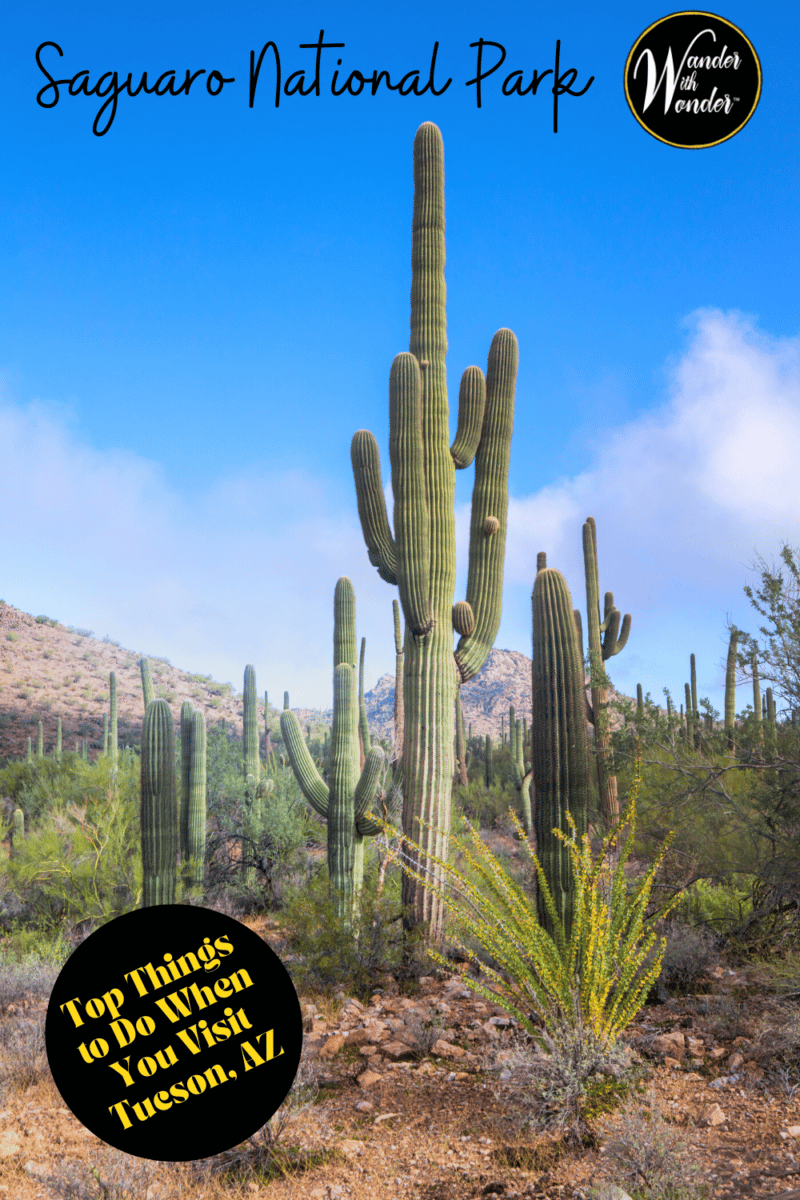
.




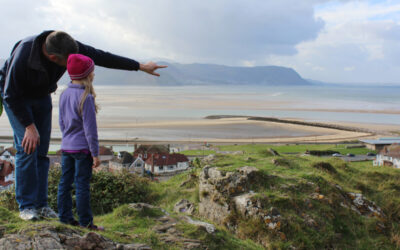

0 Comments